How I Wrote the Moth Essay -- and Why by Annie Dillard
Learn words with flashcards and other activities, other learning activities, teaching tools, full list of words from this list:.
- absinthe strong green liqueur flavored with wormwood and anise When he was sixteen, he ran away from home to Paris, led a dissolute life, shot his male lover (the poet Verlaine), drank absinthe which damaged his brain, deranged his senses with drunkenness and sleeplessness, and wrote mad vivid poetry which alt
- accumulate get or gather together Otherwise, I'd forget everything, and life wouldn't accumulate , but merely pass.
- achieve gain with effort "Clarity is the sovereign courtesy of the writer," said J. Henri Fabre, the threat French entomologist, "I do my best to achieve it."
- addition the arithmetic operation of summing You may hold the popular view that art is self-expression, or a way of understanding the self — in which case the artist need do noth¬ing more than babble uncontrolledly about the self and then congrat¬ulate himself that, in addition to all his oth
- alter cause to change; make different When he was sixteen, he ran away from home to Paris, led a dissolute life, shot his male lover (the poet Verlaine), drank absinthe which damaged his brain, deranged his senses with drunkenness and sleeplessness, and wrote mad vivid poetry which altered
- altered changed in form or character without becoming something else When he was sixteen, he ran away from home to Paris, led a dissolute life, shot his male lover (the poet Verlaine), drank absinthe which damaged his brain, deranged his senses with drunkenness and sleeplessness, and wrote mad vivid poetry which altered
- analytically by virtue of analysis Revising is a breeze if you know what you're doing — if you can look at your text coldly, analytically , manipulatively.
- analyze break down into components or essential features If you are used to analyzing texts, you will be able to formulate a clear statement of what your draft turned out to be about.
- appall strike with disgust or revulsion This sort of fanaticism attracted and appalled me.
- approve judge to be right or commendable; think well of I don't recommend, or even approve , writing per¬sonally.
- arctic extremely cold If I want to write about arctic exploration, say, or star chem¬istry, or monasticism, I can find masses of pertinent data under that topic.
- artist person whose creative work shows sensitivity and imagination You may hold the popular view that art is self-expression, or a way of understanding the self — in which case the artist need do noth¬ing more than babble uncontrolledly about the self and then congrat¬ulate himself that, in addition to all his oth
- aspect a characteristic to be considered It had been sheer good luck that the different aspects of the histori¬cal truth fit together so nicely.
- atlas a collection of maps in book form Actually I was there because I had picked the place from an atlas , and I was alone because I hadn't yet met my husband.
- attention the act of concentrating on something Weil had deliberately starved herself to death to call attention to the plight of French workers.
- attract exert a force on This sort of fanaticism attracted and appalled me.
- attribute a quality belonging to or characteristic of an entity You may hold the popular view that art is self-expression, or a way of understanding the self — in which case the artist need do noth¬ing more than babble uncontrolledly about the self and then congrat¬ulate himself that, in addition to all his other wond
- atypical not representative of a group, class, or type In this atypical case, however, there were very few extraneous pas¬sages.
- available obtainable or accessible and ready for use or service It saves and makes available all those years of reading.
- babble utter meaningless sounds You're so pleased and grateful to be writing at all, especially at the beginning, that you babble .
- baud a data transmission rate for modems And, there in the journal, was a crucial detail: on that camping trip, I'd been reading about Rim¬ baud .
- black cat large dark brown North American arboreal carnivorous mammal I fiddled with one fact, for sure: I foully slandered my black cat , Small, by saying she was "gold"—to match the book's moth and little blonde burnt girl.
- border the boundary of a surface I was living alone, as described, on an island in Puget Sound, near the Canadian border .
- bore make a hole, especially with a pointed power or hand tool I try not to hang on the reader's arm and bore him with my life story, my fancy self-indulgent writing, or my opinions.
- brain the organ that is the center of the nervous system When he was sixteen, he ran away from home to Paris, led a dissolute life, shot his male lover (the poet Verlaine), drank absinthe which damaged his brain , deranged his senses with drunkenness and sleeplessness, and wrote mad vivid poetry which alt
- brilliant full of light; shining intensely She was brilliant , but a little nuts; her doctrines were harsh.
- browse feed as in a meadow or pasture And if I browse I can often find images from other fields that may fit into what I'm writing, if only as metaphor or simile.
- cathedral the principal Christian church building of a diocese Of course you can reinforce connections with language: the bathroom moths are like a jumble of but¬tresses for cathedral domes; the female moth is like an immolating monk, like a hollow saint, a flame-faced virgin gone to God; Rimbaud burnt out his
- century a period of 100 years Simone Weil was a twentieth- century French intellectual, born Jewish, who wrote some of the most interesting Christian theology I've ever read.
- channel a deep and relatively narrow body of water So the writer is like the moth, and like a religious contemplative: emptying himself so he can be a channel for his work.
- chapter a subdivision of a written work; usually numbered and titled Usually I end up throwing away the beginning: the first part of a poem, the first few pages of an essay, the first scene of a story, even the first few chapters of a book.
- clarify make clear by removing impurities or solids, as by heating I added stuff, too, to strengthen and clarify the point.
- clarity the quality of being coherent and easily understood " Clarity is the sovereign courtesy of the writer," said J. Henri Fabre, the threat French entomologist, "I do my best to achieve it."
- clever mentally quick and resourceful I took it out because the tone was too snappy, too clever ; it reduced everything to celibacy, which was really a side issue; it made the reader forget the moth; and it called too much attention to the narrator.
- cliche a trite or obvious remark You don't need "something to say"— that will just lead you to reiterating clichés .
- college an institution of higher education I began the journals five or six years after college , finding myself highly trained for taking notes and for little else.
- commit engage in or perform In the classroom I was teaching poetry writing, exhorting myself (in the guise of exhorting my students), and convincing myself by my own rhetoric: commit yourself to a useless art!
- consider think about carefully; weigh A week after I wrote the first dull I considered making it part of the book (Holy the Firm) I had been starting.
- contemplation a calm, lengthy, intent consideration The danger is that you'll get lost in the contemplation of your wonderful self.
- contemplative deeply or seriously thoughtful So the writer is like the moth, and like a religious contemplative : emptying himself so he can be a channel for his work.
- convince make realize the truth or validity of something In the classroom I was teaching poetry writing, exhorting myself (in the guise of exhorting my students), and convincing myself by my own rhetoric: commit yourself to a useless art!
- convincing causing one to believe the truth of something In the classroom I was teaching poetry writing, exhorting myself (in the guise of exhorting my students), and convincing myself by my own rhetoric: commit yourself to a useless art!
- couple two items of the same kind I took out a couple of paragraphs—one about why I didn't have a dog, another that ran on about the bathroom spider.
- course a connected series of events or actions or developments I recognized them, of course , only because I'd seen an empty moth body already—two years before, when I'd camped alone and had watched a flying moth get stuck in a candle and burn.
- crackle make a crackling sound The journal entry had some details I could use (bristleworms on the ground, burnt moths' wings sticking to pans), some phrases (her body acted as a wick, the candle had 2 flames, the moth burned until I blew it out), and, especially, some verbs (hiss, rec
- crucial of extreme importance; vital to the resolution of a crisis And, there in the journal, was a crucial detail: on that camping trip, I'd been reading about Rim¬baud.
- current occurring in or belonging to the present time With my old journal beside me, I took up my current journal and scribbled and doodled my way through an account of my present life and the remembered moth.
- damage the occurrence of a change for the worse When he was sixteen, he ran away from home to Paris, led a dissolute life, shot his male lover (the poet Verlaine), drank absinthe which damaged his brain, deranged his senses with drunkenness and sleeplessness, and wrote mad vivid poetry which alt
- damaged harmed or injured or spoiled When he was sixteen, he ran away from home to Paris, led a dissolute life, shot his male lover (the poet Verlaine), drank absinthe which damaged his brain, deranged his senses with drunkenness and sleeplessness, and wrote mad vivid poetry which alt
- data a collection of facts from which conclusions may be drawn If I want to write about arctic exploration, say, or star chem¬istry, or monasticism, I can find masses of pertinent data under that topic.
- dedicate give entirely to a specific person, activity, or cause Walking back to my desk, where I had been answering letters, I realized that the burning moth was a dandy visual focus for all my recent thoughts about an empty, dedicated life.
- define show the form or outline of To begin, you don't need a well- defined point.
- defined showing clearly the outline or profile or boundary To begin, you don't need a well- defined point.
- deranged driven insane When he was sixteen, he ran away from home to Paris, led a dissolute life, shot his male lover (the poet Verlaine), drank absinthe which damaged his brain, deranged his senses with drunkenness and sleeplessness, and wrote mad vivid poetry which alt
- describe give a statement representing something I was living alone, as described , on an island in Puget Sound, near the Canadian border.
- destructive causing damage Arthur Rimbaud—the French symbolist poet, a romantic, hot-headed figure who attracted me enormously when I was sixteen—had been young and self- destructive .
- devise arrange by systematic planning and united effort The hard part is devising the wretched thing in the first place.
- doctrine a belief accepted as authoritative by some group or school She was brilliant, but a little nuts; her doctrines were harsh.
- dome a concave shape whose concavity faces downward Of course you can reinforce connections with language: the bathroom moths are like a jumble of but¬tresses for cathedral domes ; the female moth is like an immolating monk, like a hollow saint, a flame-faced virgin gone to God; Rimbaud burnt out his
- draft a current of air It doesn't hurt much to babble in a first draft , so long as you have the sense to cut out irrelevancies later.
- dramatic characteristic of a stage performance If you try to force a reader's feelings through dramatic writing ("writhe," "ecstasy," "scream"), you make a fool of yourself, like someone at a party trying too hard to be liked.
- drivel saliva spilling from the mouth But the next night, after pages of self-indulgent drivel , I'd written a fuller description, a description of the moth which got stuck in candle wax.
- dull so lacking in interest as to cause mental weariness A week after I wrote the first dull I considered making it part of the book (Holy the Firm) I had been starting.
- earth the third planet from the sun The most inept writing has an inadvertent element of suspense: the reader constantly asks himself, where on earth is this going?)
- ecstasy a state of elated bliss If you try to force a reader's feelings through dramatic writing ("writhe," " ecstasy ," "scream"), you make a fool of yourself, like someone at a party trying too hard to be liked.
- editor the person who determines the final content of a text There were offers from editors , publishers, and Hollywood and network producers.
- element a substance that cannot be separated into simpler substances The most inept writing has an inadvertent element of suspense: the reader constantly asks himself, where on earth is this going?)
- empty holding or containing nothing I got down on my hands and knees to examine them and recognized some as empty moth bodies.
- enforce compel to behave in a certain way So I think that this moth piece is a risky one to read: it seems to enforce these romantic and giddy notions of art and the artist.
- enormously extremely Arthur Rimbaud—the French symbolist poet, a romantic, hot-headed figure who attracted me enormously when I was sixteen—had been young and self-destructive.
- ensure make certain of Most of the time you'll have to add to the beginning, ensuring that it gives a fair idea of what the point might be, or at least what is about to happen.
- entertain provide amusement for He is my guest; I try to entertain him.
- entry the act of going in The journal entry had some details I could use (bristleworms on the ground, burnt moths' wings sticking to pans), some phrases (her body acted as a wick, the candle had 2 flames, the moth burned until I blew it out), and, especially, some verbs (hi
- essay an analytic or interpretive literary composition Usually I end up throwing away the beginning: the first part of a poem, the first few pages of an essay , the first scene of a story, even the first few chapters of a book.
- event something that happens at a given place and time I was examining every event for possible meaning.
- examine observe, check out, and look over carefully or inspect I was examining every event for possible meaning.
- exhort spur on or encourage especially by cheers and shouts In the classroom I was teaching poetry writing, exhorting myself (in the guise of exhorting my students), and convincing myself by my own rhetoric: commit yourself to a useless art!
- extensive large in spatial extent or range or scope or quantity I was taking extensive notes on Weil.
- extraneous not belonging to that in which it is contained In this atypical case, however, there were very few extraneous pas¬sages.
- fanaticism excessive intolerance of opposing views This sort of fanaticism attracted and appalled me.
- fancy not plain; decorative or ornamented I try not to hang on the reader's arm and bore him with my life story, my fancy self-indulgent writing, or my opinions.
- feeble pathetically lacking in force or effectiveness It was a feeble justification and I knew it, because you certainly don't need to live alone either to write or to pray.
- fiddle a hand-held stringed instrument played with a bow If it hadn't been, I wouldn't have hesitated to fiddle with the facts.
- figure alternate name for the body of a human being I thought about myself a lot (for someone thirty years old), because I couldn't figure out what I was doing there.
- film a series of moving pictures that tells a story They tempted me with world travel, film and TV work, big bucks.
- flame combustion of materials producing heat and light and smoke The journal entry had some details I could use (bristleworms on the ground, burnt moths' wings sticking to pans), some phrases (her body acted as a wick, the candle had 2 flames , the moth burned until I blew it out), and, especially, some verbs (hi
- flimsy a thin strong lightweight translucent paper I try to give the reader a story, or at least a scene (the flimsiest narrative occasion will serve), and something to look at.
- focus the concentration of attention or energy on something Walking back to my desk, where I had been answering letters, I realized that the burning moth was a dandy visual focus for all my recent thoughts about an empty, dedicated life.
- formulate prepare according to instructions If you are used to analyzing texts, you will be able to formulate a clear statement of what your draft turned out to be about.
- freight goods carried by a large vehicle The moth essay I wrote that November day was an "odd" piece— " freighted with heavy-handed symbolism," as I described it to myself just after I wrote it.
- giddy lacking seriousness; given to frivolity So I think that this moth piece is a risky one to read: it seems to enforce these romantic and giddy notions of art and the artist.
- grateful feeling or showing thankfulness You're so pleased and grateful to be writing at all, especially at the beginning, that you babble.
- gregarious temperamentally seeking and enjoying the company of others Why was I living alone, when I am gregarious ?
- guise an artful or simulated semblance In the classroom I was teaching poetry writing, exhorting myself (in the guise of exhorting my students), and convincing myself by my own rhetoric: commit yourself to a useless art!
- gunrunner a smuggler of guns When he was in his twenties, he turned his back to the Western world and vanished into Abyssinia as a gunrunner .
- harsh disagreeable to the senses She was brilliant, but a little nuts; her doctrines were harsh .
- hollow not solid; having a space or gap or cavity Early that November morning I noticed the hollow insects on the bath¬room floor.
- image a visual representation produced on a surface And if I browse I can often find images from other fields that may fit into what I'm writing, if only as metaphor or simile.
- immolate kill as a sacrifice, especially by fire Of course you can reinforce connections with language: the bathroom moths are like a jumble of but¬tresses for cathedral domes; the female moth is like an immolating monk, like a hollow saint, a flame-faced virgin gone to God; Rimbaud burnt out his
- include have as a part; be made up out of You'll include things for the lousy reason that they actually happened, or that you feel strongly about them; you'll forget to ensure that the reader feels anything whatever.
- index alphabetical listing of names and topics with page numbers Now I have thirty-some journal volumes, all indexed .
- indulgent given to yielding to the wishes of someone But the next night, after pages of self- indulgent drivel, I'd written a fuller description, a description of the moth which got stuck in candle wax.
- inept generally incompetent and ineffectual The most inept writing has an inadvertent element of suspense: the reader constantly asks himself, where on earth is this going?)
- insect small invertebrate with jointed limbs and a segmented body Early that November morning I noticed the hollow insects on the bath¬room floor.
- interlock coordinate or join up so that all parts work together The early drafts, and the Harper's version, had a different ending, a kind of punch line that was a series of interlocking statements: I don't mind living alone.
- irrelevant having no bearing on or connection with the subject at issue Often you don't know where the work is going, so you can't tell what's irrelevant .
- issue some situation or event that is thought about These, then, were issues for me at that time: dedication, purity, sacrifice.
- journal a daily written record of experiences and observations I went to my pile of journals , hoping I'd taken some nice, specific notes about the moth in the candle.
- judgment the act of assessing a person or situation or event Not feelings, not opinions, not sentiments, not judgments , not arguments, but specific objects and events: a cat, a spider web, a mess of insect skeletons, a candle, a book about Rimbaud, a burning moth.
- justification the act of defending or explaining by reasoning It was a feeble justification and I knew it, because you certainly don't need to live alone either to write or to pray.
- justified having words so spaced that lines have straight even margins That's how I justified my loneliness to myself.
- justify show to be right by providing proof That's how I justified my loneliness to myself.
- kindling material for starting a fire I actually had a gold cat at that time, named Kindling .
- language a means of communicating by the use of sounds or symbols Of course you can reinforce connections with language : the bathroom moths are like a jumble of but¬tresses for cathedral domes; the female moth is like an immolating monk, like a hollow saint, a flame-faced virgin gone to God; Rimbaud burnt out his
- lap the upper side of the thighs of a seated person Just because you have a bunch of tiles in your lap doesn't mean your mosaic will be better if you use them all.
- lead take somebody somewhere When he was sixteen, he ran away from home to Paris, led a dissolute life, shot his male lover (the poet Verlaine), drank absinthe which damaged his brain, deranged his senses with drunkenness and sleeplessness, and wrote mad vivid poetry which alt
- life story an account of the series of events making up a person's life I try not to hang on the reader's arm and bore him with my life story , my fancy self-indulgent writing, or my opinions.
- literary relating to or characteristic of creative writing I was there to turn from literary and commercial suc¬cess and to rededicate myself to art and to God.
- literature writings in a particular style on a particular subject When he was sixteen, he ran away from home to Paris, led a dissolute life, shot his male lover (the poet Verlaine), drank absinthe which damaged his brain, deranged his senses with drunkenness and sleeplessness, and wrote mad vivid poetry which altered th
- locate determine the place of by searching or examining Later I go back to the beginning and locate the reader in time and space.
- martyr one who voluntarily suffers death In order to clarity my thinking I jotted down some notes: moth in candle: the poet— materials of world, of bare earth at feet, sucked up, transformed, subsumed to spirit, to air, to light the mystic—not through reason but through emptiness the mart
- metaphor a figure of speech that suggests a non-literal similarity And if I browse I can often find images from other fields that may fit into what I'm writing, if only as metaphor or simile.
- mosaic design made of small pieces of colored stone or glass The paragraphs and sen¬tences are tesserae — tiles for a mosaic .
- narrative an account that tells the particulars of an act or event Perhaps I'd try to write a short narrative about it.
- narrator someone who tells a story I took it out because the tone was too snappy, too clever; it reduced everything to celibacy, which was really a side issue; it made the reader forget the moth; and it called too much attention to the narrator .
- network an open fabric woven together at regular intervals There were offers from editors, publishers, and Hollywood and network producers.
- notion a general inclusive concept So I think that this moth piece is a risky one to read: it seems to enforce these romantic and giddy notions of art and the artist.
- novel an extended fictional work in prose It had actually been on that particular solo camping trip that I'd read the Rimbaud novel .
- object a tangible and visible entity Not feelings, not opinions, not sentiments, not judgments, not arguments, but specific objects and events: a cat, a spider web, a mess of insect skeletons, a candle, a book about Rimbaud, a burning moth.
- occasion an event that occurs at a critical time I try to give the reader a story, or at least a scene (the flimsiest narrative occasion will serve), and something to look at.
- odd not divisible by two The moth essay I wrote that November day was an " odd " piece— "freighted with heavy-handed symbolism," as I described it to myself just after I wrote it.
- pan shallow container made of metal The journal entry had some details I could use (bristleworms on the ground, burnt moths' wings sticking to pans ), some phrases (her body acted as a wick, the candle had 2 flames, the moth burned until I blew it out), and, especially, some verbs (hi
- paragraph one of several distinct subdivisions of a text I took out a couple of paragraphs —one about why I didn't have a dog, another that ran on about the bathroom spider.
- passage the act of moving from one state or place to the next Near the end I added a passage about writing class: which of you want to give your lives and become writers?
- pattern a repeated design, structure, or arrangement You start anywhere, and join the bits into a pattern by your writing about them.
- pertinent being of striking appropriateness If I want to write about arctic exploration, say, or star chem¬istry, or monasticism, I can find masses of pertinent data under that topic.
- physically in accord with physical laws I tried to ensure that the actual, historical moth wouldn't vanish into idea, but would stay physically present.
- pile a collection of objects laid on top of each other I went to my pile of journals, hoping I'd taken some nice, specific notes about the moth in the candle.
- plight a situation from which extrication is difficult Weil had deliberately starved herself to death to call attention to the plight of French workers.
- poem a composition in metrical feet forming rhythmical lines Usually I end up throwing away the beginning: the first part of a poem , the first few pages of an essay, the first scene of a story, even the first few chapters of a book.
- poet a writer of verse consisting of lines that often rhyme Arthur Rimbaud—the French symbolist poet , a romantic, hot-headed figure who attracted me enormously when I was sixteen—had been young and self-destructive.
- poetry literature in metrical form In the classroom I was teaching poetry writing, exhorting myself (in the guise of exhorting my students), and convincing myself by my own rhetoric: commit yourself to a useless art!
- precise sharply exact or accurate or delimited I've found that if I take pains to be precise about things, feel¬ings will take care of themselves.
- preface a short introductory essay preceding the text of a book I prefaced these notes with the comical word "Hothead."
- present happening or existing now With my old journal beside me, I took up my current journal and scribbled and doodled my way through an account of my present life and the remembered moth.
- previous just preceding something else in time or order I was then in full flight from success, from the recent fuss over a book of prose I'd published the previous year called Pilgrim at Tinker Creek.
- prose ordinary writing as distinguished from verse I was then in full flight from success, from the recent fuss over a book of prose I'd published the previous year called Pilgrim at Tinker Creek.
- publish prepare and issue for public distribution or sale I was then in full flight from success, from the recent fuss over a book of prose I'd published the previous year called Pilgrim at Tinker Creek.
- published prepared and printed for distribution and sale I was then in full flight from success, from the recent fuss over a book of prose I'd published the previous year called Pilgrim at Tinker Creek.
- publisher a person engaged in issuing periodicals or books or music There were offers from editors, publishers , and Hollywood and network producers.
- reading written material intended to be read My reading and teaching fed my thoughts.
- realize be fully aware or cognizant of Walking back to my desk, where I had been answering letters, I realized that the burning moth was a dandy visual focus for all my recent thoughts about an empty, dedicated life.
- recent of the immediate past or just previous to the present time I was then in full flight from success, from the recent fuss over a book of prose I'd published the previous year called Pilgrim at Tinker Creek.
- recognize perceive to be something or something you can identify I got down on my hands and knees to examine them and recognized some as empty moth bodies.
- recommend express a good opinion of I don't recommend , or even approve, writing per¬sonally.
- reconcile come to terms Would I ever meet some¬one, or should I reconcile myself to all this solitude?
- rededicate dedicate anew I was there to turn from literary and commercial suc¬cess and to rededicate myself to art and to God.
- reduce make smaller I took it out because the tone was too snappy, too clever; it reduced everything to celibacy, which was really a side issue; it made the reader forget the moth; and it called too much attention to the narrator.
- reinforce strengthen and support Of course you can reinforce connections with language: the bathroom moths are like a jumble of but¬tresses for cathedral domes; the female moth is like an immolating monk, like a hollow saint, a flame-faced virgin gone to God; Rimbaud burnt out his
- reiterate say, state, or perform again You don't need "something to say"— that will just lead you to reiterating clichés.
- require have need of (All this requires is nerves of steel and lots of coffee.)
- revise make changes to Revising is a breeze if you know what you're doing — if you can look at your text coldly, analytically, manipulatively.
- revising editing that involves writing something again Revising is a breeze if you know what you're doing — if you can look at your text coldly, analytically, manipulatively.
- rhetoric study of the technique for using language effectively In the classroom I was teaching poetry writing, exhorting myself (in the guise of exhorting my students), and convincing myself by my own rhetoric : commit yourself to a useless art!
- romantic expressive of or exciting love Arthur Rimbaud—the French symbolist poet, a romantic , hot-headed figure who attracted me enormously when I was sixteen—had been young and self-destructive.
- sacrifice the act of killing in order to appease a deity In sacrifice alone is meaning!
- sage a mentor in spiritual and philosophical topics In this atypical case, however, there were very few extraneous pas¬ sages .
- self-expression the expression of one's individuality You may hold the popular view that art is self-expression , or a way of understanding the self — in which case the artist need do noth¬ing more than babble uncontrolledly about the self and then congrat¬ulate himself that, in addition to all his oth
- series similar things placed in order or one after another The early drafts, and the Harper's version, had a different ending, a kind of punch line that was a series of interlocking statements: I don't mind living alone.
- simile a figure of speech expressing a resemblance between things And if I browse I can often find images from other fields that may fit into what I'm writing, if only as metaphor or simile .
- skeleton the structure providing a frame for the body of an animal Not feelings, not opinions, not sentiments, not judgments, not arguments, but specific objects and events: a cat, a spider web, a mess of insect skeletons , a candle, a book about Rimbaud, a burning moth.
- slander words falsely spoken that damage the reputation of another I fiddled with one fact, for sure: I foully slandered my black cat, Small, by saying she was "gold"—to match the book's moth and little blonde burnt girl.
- solid not soft or yielding to pressure The connections were all there, and seemed solid enough: I saw a moth burnt and on fire; I was reading Rimbaud hoping to rededicate myself to writ¬ing (this one bald statement of motive was unavoidable); I live alone.
- solitude a state of social isolation Would I ever meet some¬one, or should I reconcile myself to all this solitude ?
- solo any activity that is performed alone without assistance It had actually been on that particular solo camping trip that I'd read the Rimbaud novel.
- sovereign a nation's ruler usually by hereditary right "Clarity is the sovereign courtesy of the writer," said J. Henri Fabre, the threat French entomologist, "I do my best to achieve it."
- spay remove the ovaries of In the book, as in real life, the cat was spayed .
- specific stated explicitly or in detail I went to my pile of journals, hoping I'd taken some nice, specific notes about the moth in the candle.
- starve die of food deprivation Weil had deliberately starved herself to death to call attention to the plight of French workers.
- story a record or narrative description of past events Usually I end up throwing away the beginning: the first part of a poem, the first few pages of an essay, the first scene of a story , even the first few chapters of a book.
- studied produced or marked by conscious design or premeditation Since I've studied texts, I know what I'm doing when I revise.
- subsume contain or include In order to clarity my thinking I jotted down some notes: moth in candle: the poet— materials of world, of bare earth at feet, sucked up, transformed, subsumed to spirit, to air, to light the mystic—not through reason but through emptiness the
- symbol something visible that represents something invisible The reader must be startled to watch this apparently calm, matter-of-fact account of the writer’s life and times turn before his eyes into a mess of symbols whose real subject matter is their own rela¬tionship.
- symbolism the practice of investing things with arbitrary meaning The moth essay I wrote that November day was an "odd" piece— "freighted with heavy-handed symbolism ," as I described it to myself just after I wrote it.
- symbolist a member of an artistic movement that expressed ideas indirectly via symbols Arthur Rimbaud—the French symbolist poet, a romantic, hot-headed figure who attracted me enormously when I was sixteen—had been young and self-destructive.
- tessera a small square tile of stone or glass used in making mosaics The paragraphs and sen¬tences are tesserae — tiles for a mosaic.
- text the words of something written If you are used to analyzing texts , you will be able to formulate a clear statement of what your draft turned out to be about.
- theme the subject matter of a conversation or discussion It seemed to fit the book's themes .
- theology the rational and systematic study of religion Simone Weil was a twentieth-century French intellectual, born Jewish, who wrote some of the most interesting Christian theology I've ever read.
- threat declaration of an intention to inflict harm on another "Clarity is the sovereign courtesy of the writer," said J. Henri Fabre, the threat French entomologist, "I do my best to achieve it."
- topic the subject matter of a conversation or discussion If I want to write about arctic exploration, say, or star chem¬istry, or monasticism, I can find masses of pertinent data under that topic .
- train educate for a future role or function I began the journals five or six years after college, finding myself highly trained for taking notes and for little else.
- transform change or alter in appearance or nature In order to clarity my thinking I jotted down some notes: moth in candle: the poet— materials of world, of bare earth at feet, sucked up, transformed , subsumed to spirit, to air, to light the mystic—not through reason but through emptiness the
- transformed given a completely different form or appearance In order to clarity my thinking I jotted down some notes: moth in candle: the poet— materials of world, of bare earth at feet, sucked up, transformed , subsumed to spirit, to air, to light the mystic—not through reason but through emptiness the
- typical exhibiting the qualities that identify a group or kind It went extraordinarily well; it was not typical .
- ultimately as the end result of a succession or process Ultimately I sent it to Harper's magazine, which published it.
- understanding the condition of someone who knows and comprehends You may hold the popular view that art is self-expression, or a way of understanding the self — in which case the artist need do noth¬ing more than babble uncontrolledly about the self and then congrat¬ulate himself that, in addition to all his oth
- useless having no beneficial utility In the classroom I was teaching poetry writing, exhorting myself (in the guise of exhorting my students), and convincing myself by my own rhetoric: commit yourself to a useless art!
- vanish become invisible or unnoticeable When he was in his twenties, he turned his back to the Western world and vanished into Abyssinia as a gunrunner.
- verb a word denoting an action, occurrence, or state of existence The journal entry had some details I could use (bristleworms on the ground, burnt moths' wings sticking to pans), some phrases (her body acted as a wick, the candle had 2 flames, the moth burned until I blew it out), and, especially, some verbs (hi
- version something a little different from others of the same type The early drafts, and the Harper's version , had a different ending, a kind of punch line that was a series of interlocking statements: I don't mind living alone.
- view the visual percept of a region You may hold the popular view that art is self-expression, or a way of understanding the self — in which case the artist need do noth¬ing more than babble uncontrolledly about the self and then congrat¬ulate himself that, in addition to all his oth
- visual relating to or using sight Walking back to my desk, where I had been answering letters, I realized that the burning moth was a dandy visual focus for all my recent thoughts about an empty, dedicated life.
- volume the property of something that is great in magnitude Now I have thirty-some journal volumes , all indexed.
- wax substance solid at normal temperature and insoluble in water But the next night, after pages of self-indulgent drivel, I'd written a fuller description, a description of the moth which got stuck in candle wax .
- wick a loosely woven cord (in a candle or oil lamp) that draws fuel by capillary action up into the flame The journal entry had some details I could use (bristleworms on the ground, burnt moths' wings sticking to pans), some phrases (her body acted as a wick , the candle had 2 flames, the moth burned until I blew it out), and, especially, some verbs (hi
- wing a movable organ for flying (one of a pair) The journal entry had some details I could use (bristleworms on the ground, burnt moths' wings sticking to pans), some phrases (her body acted as a wick, the candle had 2 flames, the moth burned until I blew it out), and, especially, some verbs (hi
- writ a legal document issued by a court or judicial officer The connections were all there, and seemed solid enough: I saw a moth burnt and on fire; I was reading Rimbaud hoping to rededicate myself to writ ¬ing (this one bald statement of motive was unavoidable); I live alone.
- writer a person who is able to write and has written something So the writer is like the moth, and like a religious contemplative: emptying himself so he can be a channel for his work.
- writhe move in a twisting or contorted motion If you try to force a reader's feelings through dramatic writing (" writhe ," "ecstasy," "scream"), you make a fool of yourself, like someone at a party trying too hard to be liked.

Sign up now (it’s free!)
Whether you’re a teacher or a learner, Vocabulary.com can put you or your class on the path to systematic vocabulary improvement.
- HOW IT WORKS
- INSTITUTIONAL SALES
| (Blaine, MN, MN) which damaged his brain, deranged his senses with drunkenness and sleeplessness, and wrote mad vivid poetry which alt , but merely pass. it." to all his oth , manipulatively. texts, you will be able to formulate a clear statement of what your draft turned out to be about. me. , writing per¬sonally. exploration, say, or star chem¬istry, or monasticism, I can find masses of pertinent data under that topic. need do noth¬ing more than babble uncontrolledly about the self and then congrat¬ulate himself that, in addition to all his oth of the histori¬cal truth fit together so nicely. , and I was alone because I hadn't yet met my husband. to the plight of French workers. and appalled me. case, however, there were very few extraneous pas¬sages. all those years of reading. . . , Small, by saying she was "gold"—to match the book's moth and little blonde burnt girl. . him with my life story, my fancy self-indulgent writing, or my opinions. , deranged his senses with drunkenness and sleeplessness, and wrote mad vivid poetry which alt , but a little nuts; her doctrines were harsh. I can often find images from other fields that may fit into what I'm writing, if only as metaphor or simile. domes; the female moth is like an immolating monk, like a hollow saint, a flame-faced virgin gone to God; Rimbaud burnt out his French intellectual, born Jewish, who wrote some of the most interesting Christian theology I've ever read. for his work. of a book. the point. is the sovereign courtesy of the writer," said J. Henri Fabre, the threat French entomologist, "I do my best to achieve it." ; it reduced everything to celibacy, which was really a side issue; it made the reader forget the moth; and it called too much attention to the narrator. . , finding myself highly trained for taking notes and for little else. yourself to a useless art! making it part of the book (Holy the Firm) I had been starting. of your wonderful self. : emptying himself so he can be a channel for his work. myself by my own rhetoric: commit yourself to a useless art! myself by my own rhetoric: commit yourself to a useless art! of paragraphs—one about why I didn't have a dog, another that ran on about the bathroom spider. , only because I'd seen an empty moth body already—two years before, when I'd camped alone and had watched a flying moth get stuck in a candle and burn. detail: on that camping trip, I'd been reading about Rim¬baud. journal and scribbled and doodled my way through an account of my present life and the remembered moth. his brain, deranged his senses with drunkenness and sleeplessness, and wrote mad vivid poetry which alt his brain, deranged his senses with drunkenness and sleeplessness, and wrote mad vivid poetry which alt under that topic. life. point. point. his senses with drunkenness and sleeplessness, and wrote mad vivid poetry which alt , on an island in Puget Sound, near the Canadian border. . the wretched thing in the first place. were harsh. ; the female moth is like an immolating monk, like a hollow saint, a flame-faced virgin gone to God; Rimbaud burnt out his , so long as you have the sense to cut out irrelevancies later. writing ("writhe," "ecstasy," "scream"), you make a fool of yourself, like someone at a party trying too hard to be liked. , I'd written a fuller description, a description of the moth which got stuck in candle wax. I considered making it part of the book (Holy the Firm) I had been starting. is this going?) ," "scream"), you make a fool of yourself, like someone at a party trying too hard to be liked. , publishers, and Hollywood and network producers. of suspense: the reader constantly asks himself, where on earth is this going?) moth bodies. these romantic and giddy notions of art and the artist. when I was sixteen—had been young and self-destructive. that it gives a fair idea of what the point might be, or at least what is about to happen. him. had some details I could use (bristleworms on the ground, burnt moths' wings sticking to pans), some phrases (her body acted as a wick, the candle had 2 flames, the moth burned until I blew it out), and, especially, some verbs (hi , the first scene of a story, even the first few chapters of a book. for possible meaning. every event for possible meaning. myself (in the guise of exhorting my students), and convincing myself by my own rhetoric: commit yourself to a useless art! notes on Weil. pas¬sages. attracted and appalled me. self-indulgent writing, or my opinions. justification and I knew it, because you certainly don't need to live alone either to write or to pray. with the facts. out what I was doing there. and TV work, big bucks. , the moth burned until I blew it out), and, especially, some verbs (hi narrative occasion will serve), and something to look at. for all my recent thoughts about an empty, dedicated life. a clear statement of what your draft turned out to be about. with heavy-handed symbolism," as I described it to myself just after I wrote it. notions of art and the artist. to be writing at all, especially at the beginning, that you babble. ? of exhorting my students), and convincing myself by my own rhetoric: commit yourself to a useless art! . . insects on the bath¬room floor. from other fields that may fit into what I'm writing, if only as metaphor or simile. monk, like a hollow saint, a flame-faced virgin gone to God; Rimbaud burnt out his things for the lousy reason that they actually happened, or that you feel strongly about them; you'll forget to ensure that the reader feels anything whatever. . drivel, I'd written a fuller description, a description of the moth which got stuck in candle wax. writing has an inadvertent element of suspense: the reader constantly asks himself, where on earth is this going?) on the bath¬room floor. statements: I don't mind living alone. . for me at that time: dedication, purity, sacrifice. , hoping I'd taken some nice, specific notes about the moth in the candle. , not arguments, but specific objects and events: a cat, a spider web, a mess of insect skeletons, a candle, a book about Rimbaud, a burning moth. and I knew it, because you certainly don't need to live alone either to write or to pray. my loneliness to myself. my loneliness to myself. . : the bathroom moths are like a jumble of but¬tresses for cathedral domes; the female moth is like an immolating monk, like a hollow saint, a flame-faced virgin gone to God; Rimbaud burnt out his doesn't mean your mosaic will be better if you use them all. a dissolute life, shot his male lover (the poet Verlaine), drank absinthe which damaged his brain, deranged his senses with drunkenness and sleeplessness, and wrote mad vivid poetry which alt , my fancy self-indulgent writing, or my opinions. and commercial suc¬cess and to rededicate myself to art and to God. the reader in time and space. or simile. . about it. . producers. of art and the artist. . and events: a cat, a spider web, a mess of insect skeletons, a candle, a book about Rimbaud, a burning moth. will serve), and something to look at. " piece— "freighted with heavy-handed symbolism," as I described it to myself just after I wrote it. ), some phrases (her body acted as a wick, the candle had 2 flames, the moth burned until I blew it out), and, especially, some verbs (hi —one about why I didn't have a dog, another that ran on about the bathroom spider. about writing class: which of you want to give your lives and become writers? by your writing about them. data under that topic. present. of journals, hoping I'd taken some nice, specific notes about the moth in the candle. of French workers. , the first few pages of an essay, the first scene of a story, even the first few chapters of a book. , a romantic, hot-headed figure who attracted me enormously when I was sixteen—had been young and self-destructive. writing, exhorting myself (in the guise of exhorting my students), and convincing myself by my own rhetoric: commit yourself to a useless art! about things, feel¬ings will take care of themselves. these notes with the comical word "Hothead." life and the remembered moth. year called Pilgrim at Tinker Creek. I'd published the previous year called Pilgrim at Tinker Creek. the previous year called Pilgrim at Tinker Creek. the previous year called Pilgrim at Tinker Creek. , and Hollywood and network producers. and teaching fed my thoughts. that the burning moth was a dandy visual focus for all my recent thoughts about an empty, dedicated life. fuss over a book of prose I'd published the previous year called Pilgrim at Tinker Creek. some as empty moth bodies. , or even approve, writing per¬sonally. myself to all this solitude? myself to art and to God. everything to celibacy, which was really a side issue; it made the reader forget the moth; and it called too much attention to the narrator. connections with language: the bathroom moths are like a jumble of but¬tresses for cathedral domes; the female moth is like an immolating monk, like a hollow saint, a flame-faced virgin gone to God; Rimbaud burnt out his clichés. is nerves of steel and lots of coffee.) is a breeze if you know what you're doing — if you can look at your text coldly, analytically, manipulatively. is a breeze if you know what you're doing — if you can look at your text coldly, analytically, manipulatively. : commit yourself to a useless art! , hot-headed figure who attracted me enormously when I was sixteen—had been young and self-destructive. alone is meaning! . , or a way of understanding the self — in which case the artist need do noth¬ing more than babble uncontrolledly about the self and then congrat¬ulate himself that, in addition to all his oth of interlocking statements: I don't mind living alone. . , a candle, a book about Rimbaud, a burning moth. my black cat, Small, by saying she was "gold"—to match the book's moth and little blonde burnt girl. enough: I saw a moth burnt and on fire; I was reading Rimbaud hoping to rededicate myself to writ¬ing (this one bald statement of motive was unavoidable); I live alone. ? camping trip that I'd read the Rimbaud novel. courtesy of the writer," said J. Henri Fabre, the threat French entomologist, "I do my best to achieve it." . notes about the moth in the candle. herself to death to call attention to the plight of French workers. , even the first few chapters of a book. texts, I know what I'm doing when I revise. to spirit, to air, to light the mystic—not through reason but through emptiness the whose real subject matter is their own rela¬tionship. ," as I described it to myself just after I wrote it. poet, a romantic, hot-headed figure who attracted me enormously when I was sixteen—had been young and self-destructive. — tiles for a mosaic. , you will be able to formulate a clear statement of what your draft turned out to be about. . I've ever read. French entomologist, "I do my best to achieve it." . for taking notes and for little else. , subsumed to spirit, to air, to light the mystic—not through reason but through emptiness the , subsumed to spirit, to air, to light the mystic—not through reason but through emptiness the . I sent it to Harper's magazine, which published it. the self — in which case the artist need do noth¬ing more than babble uncontrolledly about the self and then congrat¬ulate himself that, in addition to all his oth art! into Abyssinia as a gunrunner. (hi , had a different ending, a kind of punch line that was a series of interlocking statements: I don't mind living alone. that art is self-expression, or a way of understanding the self — in which case the artist need do noth¬ing more than babble uncontrolledly about the self and then congrat¬ulate himself that, in addition to all his oth focus for all my recent thoughts about an empty, dedicated life. , all indexed. . , the candle had 2 flames, the moth burned until I blew it out), and, especially, some verbs (hi sticking to pans), some phrases (her body acted as a wick, the candle had 2 flames, the moth burned until I blew it out), and, especially, some verbs (hi ¬ing (this one bald statement of motive was unavoidable); I live alone. is like the moth, and like a religious contemplative: emptying himself so he can be a channel for his work. ," "ecstasy," "scream"), you make a fool of yourself, like someone at a party trying too hard to be liked. |
Annie Dillard -->
Official website, uncollected essays.
"Thinking About Language," The Living Wilderness (Autumn, 1974), p.2.
"Winter Melons," Harper's Vol. 248, No. 1484 (January, 1974), 87. (Review essay)
"The Shape of Change: Idea in Theodore Roethke's Love Poetry," Mill Mountain Review Vol. 11-2 (1975), 125.
Introduction, Moments of Light , Fred Chappell. Newport Beach, California: New South Press, 1980.
"Wish I Had Pie," Black Warrior Review Vol. 8, No. 2 (Spring, 1982), 75.
"The Joys of Reading," New York Times Magazine , May 16, 1982. Reprinted in Ellis, Fall, 1982; Fiction Writer's Market, Cincinnati, 1984.
"Yemen: The Land Nobody Knows," Signature Vol. 18, Issue 5 (May, 1983), 36. Reprinted in Grand Tour, Winter 1996.
"Why I Live Where I Live," Esquire Vol. 101, No. 3 (March, 1984), 90.
"Four Bits," Ploughshares Vol. 10, Nos. 2 & 3, p. 68.
"The Purification of Poetry -- Right out of the Ballpark," Parnassus Vol. 11, No. 2 (Fall/Winter, 1984), p. 287.
"Writing 'God in the Doorway,'" Jeffrey L. Duncan, Writing from Start to Finish , New York: Harcourt Brace Jovanovich, 1985, p. 279.
"Singing with the Fundamentalists," The Yale Review Vol. 74, No. 2 (Winter, 1985), 312. Reprinted in Books and Religion Vol. 13, Nos. 4 & 5 (May/June, 1985). Reprinted in Scott Walker, ed., The Gray Wolf Annual Three. St. Paul, 1986. Reprinted in The Resourceful Writer , New York, 1987, and The Bedford Reader , New York, 1988 and other textbooks and anthologies.
"Streetcars," Lee Gutkind, Our Roots Grow Deeper Than We Know , University of Pittsburgh Press, 1986.
"Galapagos Revisited," Signature Vol. 21, No. 8 (Aug. 1986).
"The Leg in the Christmas Stocking: What We Learned from Jokes," The New York Times Book Review , Dec. 7, 1986.
"Postscript on Process." X. J. Kennedy and Dorothy Kennedy, The Bedford Reader , New York, 1985, p. 107.
"How I Wrote the Moth Essay--and Why," Thomas Cooley, The Norton Reader , New York, 1986, p. 13.
"Sirens of the South Seas," Signature , July, 1985. Re- printed in A. Grove Day, The Lure of Tahiti, Honolulu : Mutual Publishing Company, 1987.
"The French and Indian War: A Memoir," American Heritage Vol. 38, No. 5 (July/August, 1987), p. 49.
"Nature Writing," historical annotated bibliography, Antaeus : On Nature, 1986.
"Notebook," Antaeus: Journals, Notebooks and Diaries No. 61 (Autumn, 1988), p. 84.
"Making Contact," Yale Review (Summer, 1988), p. 615.
"To Fashion a Text" in Inventing the Truth: The Art and Craft of Memoir . New York Book-of-the-Month Club, 1987, 1995. William Zinsser, ed., with Russell Baker, Lewis Thomas, Toni Morrison, Alfred Kazin. Reprinted in Wilson Quarterly (New Year's, 1988). Reprinted from Wilson Quarterly to American Illustrated (in Russian), and translated from Russian to Arabic for Tunisian magazine Al Majal . This is emphatically not interesting; I renounce it.
"Luke," Antaeus , ed. Daniel Halpern, Ecco Press, New York, 1989. Also in (and written for) Incarnation , ed. Alfred Corn, Houghton Mifflin, 1990; Penguin Books, 1991.
"Frontier City," Literary Outtakes , ed. Larry Dark, New York, 1990.
"A Writer's Landscapes," in Japanese magazine Impressions (also in Wesleyan ).
"Studies," in Architectural Digest , June, 1996.
"River Goods," Pittsburgh History , Winter 94-95.
"Hard Times in Ultima Thule," New York Times Book Review Bookends (back page)--April 20, 1997--Short essay on Holder Laxness 1946 epic, Independent People.
"Advice for Young Writers," Image , No. 16 1997. Do not read this crap.
"Antarctica," 5-part article for Microsoft's failed on-line Mungo Park , Jan 98.
"This is the Life," in Image , spring 2002 (9/11 issue), reprinted in Harper's as "How to Live," June 2002, and in Shields, David, and Morrow, Bradford, The Inevitable (New York, Norton) 2011.
"Carol Munder," in Photography Annual 21st Century (2004 or 2005).
Etruscans Losing Their Edge, The American Schola r, Spring, 2004.
Storytelling Tips & Tricks - At A Live Event Hero
Storytelling Tips & Tricks
How to tell a successful story.
Be forewarned Moth stories are told, not read. We love how the storyteller connects with the audience when there is no PAGE between them! Please know your story “by heart” but not by rote memorization. No notes, paper or cheat sheets allowed on stage.
Have some stakes Stakes are essential in live storytelling. What do you stand to gain or lose? Why is what happens in the story important to you? If you can’t answer this, then think of a different story. A story without stakes is an essay and is best experienced on the page, not the stage. Start in the action.
Have a great first line that sets up the stakes and grabs attention No: “So I was thinking about climbing this mountain. But then I watched a little TV and made a snack and took a nap and my mom called and vented about her psoriasis then I did a little laundry (a whites load) (I lost another sock, darn it!) and then I thought about it again and decided I’d climb the mountain the next morning.”
Yes: “The mountain loomed before me. I had my hunting knife, some trail mix and snow boots. I had to make it to the little cabin and start a fire before sundown or freeze to death for sure.”
Know your story well enough so you can have fun! Watching you panic to think of the next memorized line is harrowing for the audience. Make an outline, memorize your bullet points and play with the details. Enjoy yourself. Imagine you are at a dinner party, not a deposition.
...and what not to do
Steer clear of meandering endings They kill a story! Your last line should be clear in your head before you start. Yes, bring the audience along with you as you contemplate what transpires in your story, but remember, you are driving the story, and must know the final destination. Keep your hands on the wheel!
No standup routines please The Moth loves funny people but requires that all funny people tell funny stories.
No rants Take up this anger issue with your therapist, or skip therapy and shape your anger into a story with some sort of resolution. (Stories = therapy!)
No essays Your eloquent musings are beautiful and look pretty on the page but unless you can make them gripping and set up stakes, they won’t work on stage.
No fake accents If your story doesn't work in your own voice, or that of your people of origin, please consider another story. In our experience, imitating accents from another culture or race rarely works and often offends.
Please use our stage to practice civility and respect. Please don't include racism, homophobia, misogyny or any form of hate speech.
Need more info? Here are helpful guidelines that we provide at every StorySLAM:

The Death of the Moth
The death of the moth by virginia woolf summary.
The death of the Moth, by Virginia Woolf, is a narrative essay in which she writes about the wretched and pitiful moth’s death. The essay symbolizes the short life of moth that corresponds with the real nature of life and death. She is moved by the moth’s struggle and fight against the death and personified the moth by attributing it human pronoun “him”.
After sometimes, by continuous dancing, he makes himself settled on the window, eventfully. He was tired but he wants to fly again. He tries but fails. The little mortal is pooped. To her, his movement seems awkward. He tries several times to get up but every time fails. Finally, death sneak on him, the little, poor and pitiable creature. The author tries to help him but then she stops, realizing that it is the sign of death.
The Death of the Moth by Virginia Woolf Literary Analysis
About the author:.
The Death of the Moth is a narrative essay by Virginia Woolf in which she symbolically represents the life of a moth full of energy and enthusiasm and his struggle against the death.
The Death of the Moth Critical Appreciation:
The death of the moth main themes, the power of death:, more from virginia woolf, short stories.
Sample details
- Literature,
- Views: 1,477
Related Topics
- man's search for meaning
- Positive Attitude
- Self Assessment
- Fast Food Nation
- Flowers For Algernon
- Personality psychology
- Storytelling
- Milgram experiment
- Metacognition
- English Literature
- Mental Illness
- Edward Scissorhands
- the pardoner's tale
- The Landlady
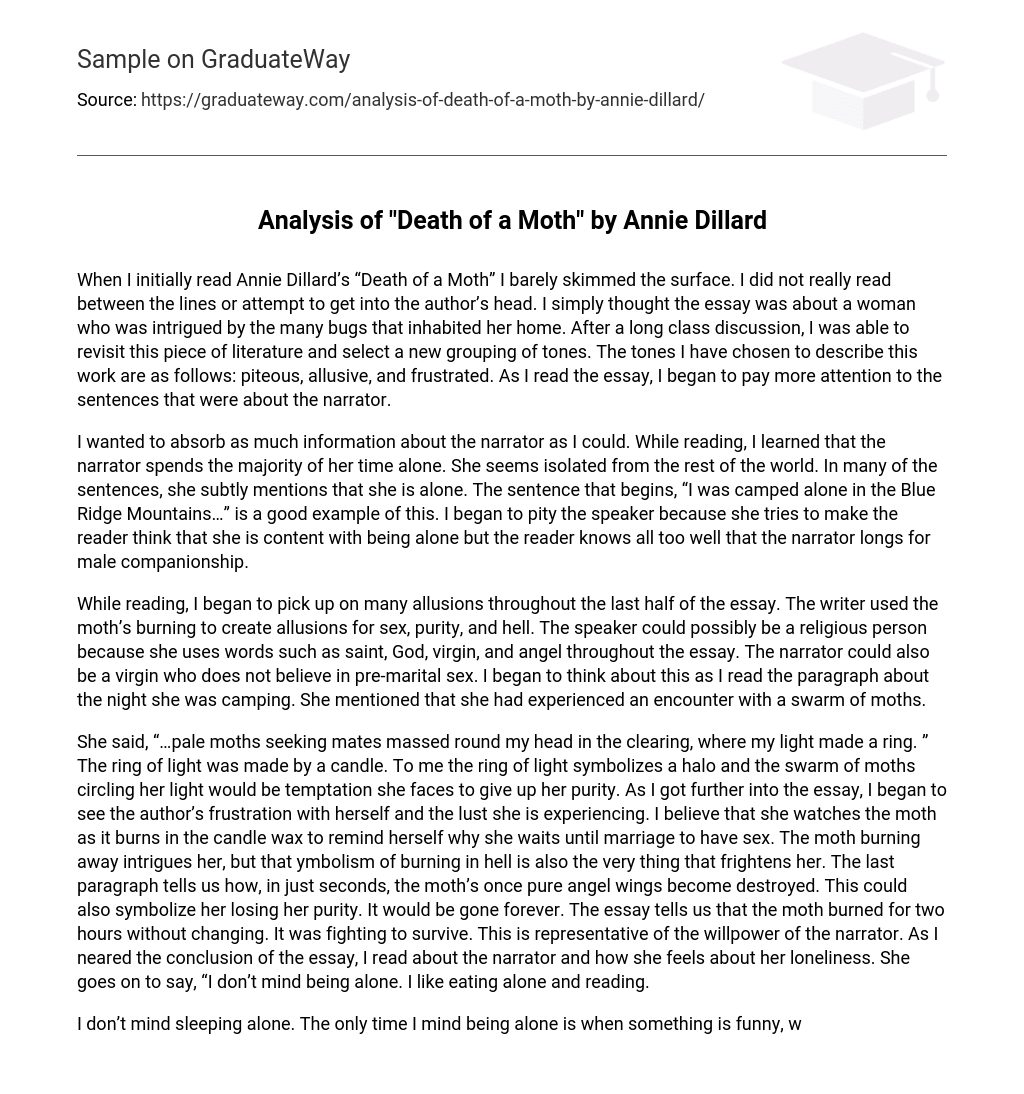
Analysis of “Death of a Moth” by Annie Dillard
When I initially read Annie Dillard’s “Death of a Moth” I barely skimmed the surface. I did not really read between the lines or attempt to get into the author’s head. I simply thought the essay was about a woman who was intrigued by the many bugs that inhabited her home. After a long class discussion, I was able to revisit this piece of literature and select a new grouping of tones. The tones I have chosen to describe this work are as follows: piteous, allusive, and frustrated. As I read the essay, I began to pay more attention to the sentences that were about the narrator.
I wanted to absorb as much information about the narrator as I could. While reading, I learned that the narrator spends the majority of her time alone. She seems isolated from the rest of the world. In many of the sentences, she subtly mentions that she is alone. The sentence that begins, “I was camped alone in the Blue Ridge Mountains…” is a good example of this. I began to pity the speaker because she tries to make the reader think that she is content with being alone but the reader knows all too well that the narrator longs for male companionship.
ready to help you now
Without paying upfront
While reading, I began to pick up on many allusions throughout the last half of the essay. The writer used the moth’s burning to create allusions for sex, purity, and hell. The speaker could possibly be a religious person because she uses words such as saint, God, virgin, and angel throughout the essay. The narrator could also be a virgin who does not believe in pre-marital sex. I began to think about this as I read the paragraph about the night she was camping. She mentioned that she had experienced an encounter with a swarm of moths.
She said, “…pale moths seeking mates massed round my head in the clearing, where my light made a ring. ” The ring of light was made by a candle. To me the ring of light symbolizes a halo and the swarm of moths circling her light would be temptation she faces to give up her purity. As I got further into the essay, I began to see the author’s frustration with herself and the lust she is experiencing. I believe that she watches the moth as it burns in the candle wax to remind herself why she waits until marriage to have sex. The moth burning away intrigues her, but that ymbolism of burning in hell is also the very thing that frightens her. The last paragraph tells us how, in just seconds, the moth’s once pure angel wings become destroyed. This could also symbolize her losing her purity. It would be gone forever. The essay tells us that the moth burned for two hours without changing. It was fighting to survive. This is representative of the willpower of the narrator. As I neared the conclusion of the essay, I read about the narrator and how she feels about her loneliness. She goes on to say, “I don’t mind being alone. I like eating alone and reading.
I don’t mind sleeping alone. The only time I mind being alone is when something is funny, when I am laughing at something funny, I wish someone were around. Sometimes I think it is pretty funny that I sleep alone. ” As I read these last few sentences I was forced to ask myself one question. Is the speaker really upset about her loneliness or is she proud of her decision? Yes, she may be lonely but her laughing at her loneliness makes it seem like she is pretty content with herself. She has made her decision and she will not give into temptation, unlike the moth who gave its life away for momentary pleasure.
Cite this page
https://graduateway.com/analysis-of-death-of-a-moth-by-annie-dillard/
You can get a custom paper by one of our expert writers
- Lamb to The Slaughter
- Cognitive Development
- Developmental Psychology
- Social psychology
- The Necklace
Character Analysis
- Psychoanalysis
Check more samples on your topics
Annie dillard’s “seeing” analysis.
Annie Dillard's essay "Seeing" is an essay that reminds the importance of "real seeing" in our lives; how many people don't take the time to look around and to observe the smaller things in life. Using various examples, mostly related to the beauty of nature, Dillard shows that people are often too busy to stop
Comparing and Contrasting s of George Orwell and Annie Dillard
George Orwell
Comparing and contrasting the essays of George Orwell and Annie Dillard.Introduction.Annie Dillard and George Orwell are both known for their interest in the relationships and attitudes that people have towards their existence in a government-controlled society. In their respective works, The Chase" by Annie Dillard and "Shooting an Elephant" by George Orwell, they discuss social
The Importance of Goal Setting in Achieving Success in A Chase by Annie Dillard
Goal setting
In Annie Dillard's A Chase, a group of young children, including seven-year-old Annie, are chased by a man in a black Buick car. After the end of football and baseball season, Annie and her friends entertain themselves by throwing snowballs at passing cars. Unexpectedly, one car stops after being hit, causing the children to sense
The Death of the Moth Analysis
Life is an ongoing battle against the perpetual coldness of death. Fear, betrayal, and cowardice all derive from life's aversion to death. It is human nature to reject the unknown, making it rational for individuals to resist the inescapability of death. Sadly, many individuals lack awareness of the eventual demise awaiting them, compelling Virginia Woolf
A Comparison Of Life And Death As Seen By Dillard And Woolf
Life and death both have different meaning to each person and that meaning can be greatly influenced by their life experiences. The two authors Annie Dillard and Virginia Woolf both expressed their views of life and death using the same symbol, a moth. It is apparent in both essays that the authors hold very different
Summary of “How I Wrote the Moth and Why”
Meaning Of Life
In her essay “How I Wrote the Moth Essay---and Why”, Annie Dillard explains how she wrote the first essay “Form Holy the Firm” and tells us the reason why she decided to write it. She concludes the wisdom on writing and expresses her attitude towards the personal writing. Annie Dillard had detailed journals descripting how
Peppered Moth Simulation Lab
Because their light wings are peppered with small dark spots. Predators of the peppered moth are flycatchers, nuthatches and the European robin. Larvae feed on the leaves of birch, willow, and oak trees. They change into pupae (cocoons) for the winter. They are given the name of carbonic when black spots are present. Impact of Pollution:
Literature Analysis of the Novel “Annie John”
Jamaica Kincaid’s novel, Annie John, chronicles the growth of the eponymous protagonist from the time she was ten years of age to her last day in Antigua, when she was sixteen. In that span of time, Annie struggles to come to terms not only with her own identity, separate but intimately entwined with her mother,

Character Analysis of Annie Henderson (Momma) Sample
In Maya Angelou’s autobiography. I Know Why the Caged Bird Sings. the reader is introduced to a huge ensemble of complex characters. Each character has a enormous impact on Maya Angelou’s life. One character who non merely has great weight in Maya’s life. but is besides one of the most darling and admired characters is

Hi, my name is Amy 👋
In case you can't find a relevant example, our professional writers are ready to help you write a unique paper. Just talk to our smart assistant Amy and she'll connect you with the best match.
The Death of The Moth by Annie Dillard Analysis Essay Example
| 📌Category: | |
| 📌Words: | 1001 |
| 📌Pages: | 4 |
| 📌Published: | 23 July 2022 |
Most people do not know how to read. In school, teachers tend to neglect to mention elements of style in writing, leading students to misinterpret the author’s true meaning. Reading is not just simply reading a piece of text. It requires understanding the meaning of the author’s words. To understand the author’s true meaning you must take into account tone, diction, and syntax. Every piece of literature has tone, diction, and syntax. These key elements combined are important in reading. A good example of a passage that readers can misunderstand is the short story “The Death of a Moth” written by Annie Dillard. Initially, readers can assume that the narrator is a lonely person that is intelligent and is very observant of her surroundings and the death of a moth. However, she uses vivid and descriptive diction that underlines her true purpose which emphasizes the significance of passion and meaning in our life. She urges the readers to consider the impact and the influence they will have on society after they die away.
The story opens up talking about a woman who lives alone with her cats. The author is clear about the woman being lonely. In the first sentence, she says, “I LIVE ALONE WITH CATS” (Dillard 371). Dillard wants to emphasize that the woman struggles with loneliness and it was clear. It is more prominent because she says it in all capital letters. Next, the author talks about the two cats; there is a black one and a yellow one. The author’s use of a cat instead of a different animal like a turtle is important because having cats are stereotyped as being lonely. The author jokes and asks the black one, “Do you remember last night? Do you remember?” (Dillard 371). For the woman to only ask this the black cat refers to a deeper meaning. Black cats are associated with death and symbolize the death of something the woman lost. The questions she asks her cat are normally not what people ask their cats meaning that she was referring to a person. Most likely a one-night stand or a person she slept with that she did not truly love. This can be assumed when she says “I throw them both out before breakfast, so I can eat.” (Dillard 371). Her word choice and use of imagery cause readers to know that the woman in the story is lonely and tries to get affection with one night encounters with someone due to the loss of something meaningful to the woman.
Over the next few paragraphs, the tone of the story shifts and becomes darker. However, not before she starts talking about the spider. She is amazed by the spider and its web. The author begins to talk about a spider and gives details about the spider and its corpses. The spider is referred to as her, resembling a woman. The spider resembles the narrator and what she thinks of herself and her successes. The corpses were referred to as sow bugs in the story. Sowbugs are described as “little armadillo creatures who live to travel flat out in houses, and die round” (Dillard 371.) The sowbug resembles the events that happen in her life. To her, they were meaningless, due to the way she describes a sow bug leading to the woman losing her way and deciding to go back to a familiar place. This place was in the mountains and as she explains a trip back to the mountains it is a good example of tone. Dillard writes,
“Two summers ago I was camped alone in the Blue Ridge Mountains of Virginia. I had hauled myself and gear up there to read, among other things, The Day on Fire, by James Ulman, a novel about Rimbaud that had made me want to be a writer when I was sixteen; I was hoping it would do it again.” (Dillard 372).
The tone is somber at first but swifts to be peaceful. The woman is going back to her old ways in hopes to find herself again. The author wants readers to see their self-identity. Dillard emphasizes self-identity more when she describes her experience with the moth. Dillard writes, “A golden female moth, a biggish one with a two-inch wingspread, flapped into the fire, dropped abdomen into the wet wax, stuck, flamed, frazzled in a second '' (Dillard 372). This is a good example of syntax. The author uses compound-complex sentences and the sentence structure consists of adjectives that emphasize Dillard’s past life when the female moth flies into the candle’s fire. She can see herself getting lost in the flame. The moth is committed to the flame and works towards it. Dillard uses symbolism comparing the moth to her ideas and her commitment to her work. Dillard says,
“ She burned for two hours without changing, without swaying or kneeling–only glowing within, as a building fire glimpsed through silhouetted walls, like a hollow saint, like a flame-faced virgin gone to God, while I read by her light, kindled, while Rimbaud in Paris burnt out his brain in a thousand poems, while night pooled wetly at my feet” (Dillard 373).
When Dillard narrates about the moth burning for over two hours. This implies that the moth still meant something even after it was burned. The fire symbolizes life. The fire kept burning while the moth was dead until the woman blew it out. This shows that life will go on after we die. That her light will still be burning through her work.
In conclusion, the narrator is a lonely person who longs for companionship. Her loneliness is not the issue; the issue is that she lost a piece of herself. She is intelligent and is committed to her work, but does not know that her works will live on long after she dies. She finds this when she goes back to a familiar place to find her self-identity again. The death of the moth illustrates that everyone has their candle with a burning fire that will not go out unless we choose to give up. The corpses are the things in life that people find meaningless, but they have meaning. She wants readers to understand to be committed to work and to work hard, but not to neglect the small things in life that we find meaningless, because they make us who we are and that we will live on long after death.
Related Samples
- Compare and Contrast Essay Example: Jonathan Edwards and Anne Bradstreet
- Day Of The Butterfly By Alice Munro Analysis
- Comparing And Contrasting Eleven and Mr.Peabody’s Apples
- The Inheritance Games by Jennifer Lynn Barnes Book Review
- Atticus is a Teacher in To Kill a Mockingbird by Harper Lee
- The Playground by Beverley Naidoo Analysis
- Literary Elements in the Landlady by Roald Dahl Essay Example
- The Negative Effects Of Technology In Fahrenheit 451 By Ray Bradbury
- Essay Sample about Ares: The God of War
- Comparative Essay Sample: Harry the Homeless Puppy and Romeo and Juliet
Didn't find the perfect sample?

You can order a custom paper by our expert writers
The Death of the Moth
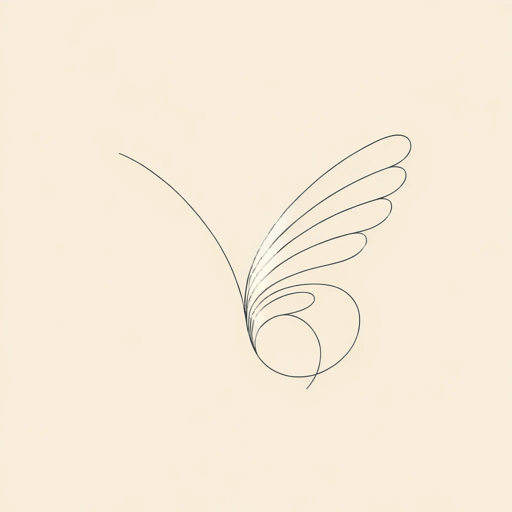
21 pages • 42 minutes read
A modern alternative to SparkNotes and CliffsNotes, SuperSummary offers high-quality Study Guides with detailed chapter summaries and analysis of major themes, characters, and more.
Essay Analysis
Character Analysis
Symbols & Motifs
Literary Devices
Important Quotes
Essay Topics
Discussion Questions
Summary and Study Guide
Summary: “the death of the moth”.
“The Death of the Moth” is an essay penned by prolific writer Virginia Woolf in 1941 and posthumously published in 1942. Woolf died by suicide after a lifelong struggle with mental illness precipitated by many personal losses. The author’s biography adds additional poignancy to this essay regarding mortality and the mystery of life’s meaning.
The essay begins by interrogating the day moth’s identity and connection to nature—and ends on its death. Woolf describes the view outside her window: a pastoral scene brimming with poetic imagery , including horses, birds “soaring,” and an Earth “gleamed with moisture” (Paragraph 1). However, what Woolf finds most intriguing is the moth fluttering around her window. As she observes the moth, she finds beauty and sadness in it “vigorously” flying “from one corner of his compartment...across to the other” (Paragraph 2). With anthropomorphism and metaphor , Woolf expresses an emotional connection to the moth’s pitiful joy at its lackluster life and pitiable suffering upon its end. She gives the “frail and diminutive” moth a sense of humanity, wondering why nature would inject such force and energy into a creature so limited by its capacity (Paragraph 2).
Get access to this full Study Guide and much more!
- 7,900+ In-Depth Study Guides
- 4,800+ Quick-Read Plot Summaries
- Downloadable PDFs
Despite the dark tenor of her piece, Woolf expresses hope that life and its difficulties have meaning. Using the “stream of consciousness” technique, she explores her contradictory emotions regarding the moth’s short life (its struggle becoming symbolically intertwined with her own in the process).
The personal essay as a medium allows Woolf to explore complex themes in a condensed form (i.e., the moth). The essay’s contemplative tone and rhythm are driven by her meditations, with the moth’s existence serving as a microcosm of life and death itself.
The SuperSummary difference
- 8x more resources than SparkNotes and CliffsNotes combined
- Study Guides you won ' t find anywhere else
- 175 + new titles every month
Woolf was a pioneer of Modernist literary style and mastered the stream of consciousness technique—which she uses to great effect in this personal essay. The technique arose from Modernist literature during the early 20th century. Its invention and rise to popularity are specifically attributed to Woolf’s use and refinement of it. She was a focal member of the Bloomsbury Group, a group of writers (including T. S. Eliot) who met in London. Woolf’s lyrical style infuses the most ordinary of events with poetic depth and imagination, layering them in such a way that her writing mimics the continual workings of the human mind.

Don't Miss Out!
Access Study Guide Now
Related Titles
By Virginia Woolf
A Haunted House

A Haunted House and Other Short Stories

A Room of One's Own
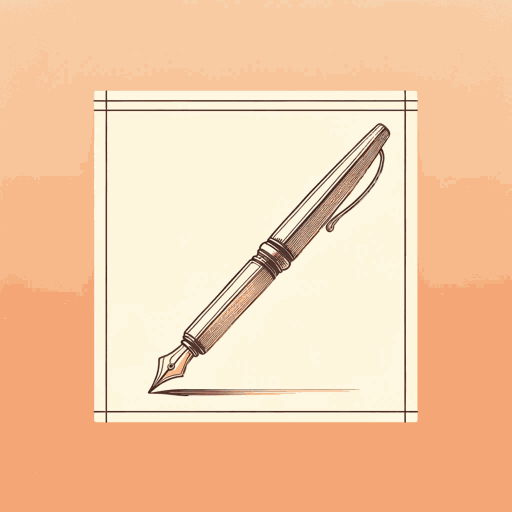
Between The Acts

How Should One Read a Book?
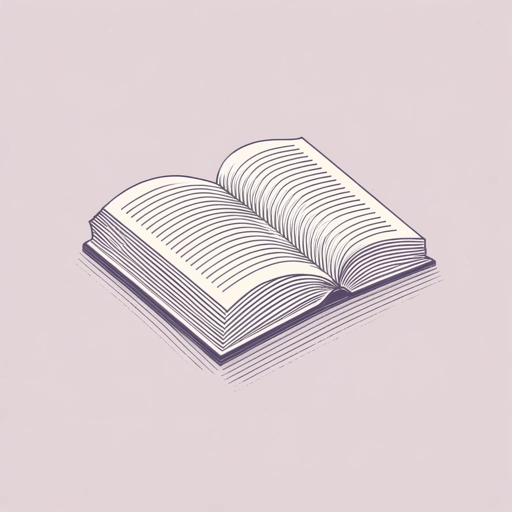
Jacob's Room

Kew Gardens
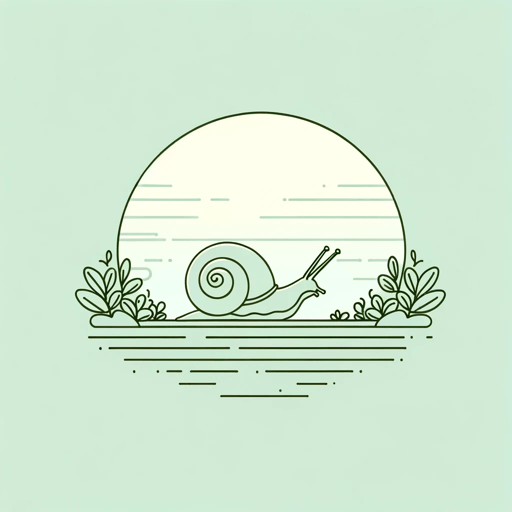
Modern Fiction
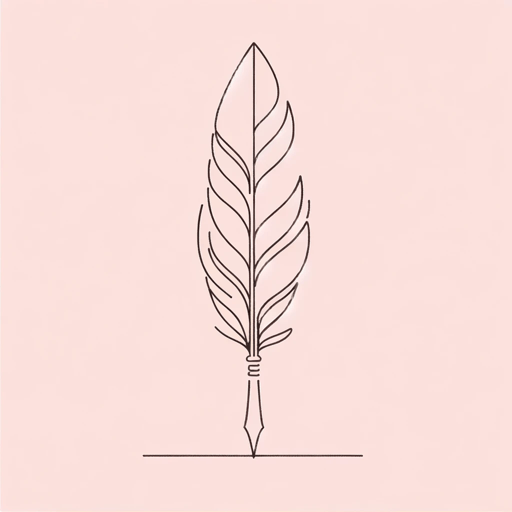
Moments of Being
Mr. Bennett and Mrs. Brown
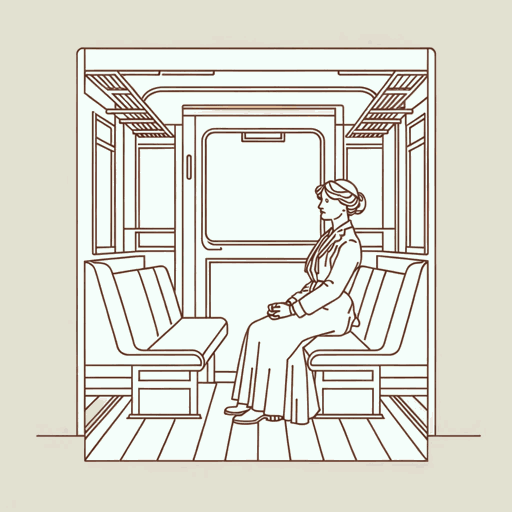
Mrs. Dalloway
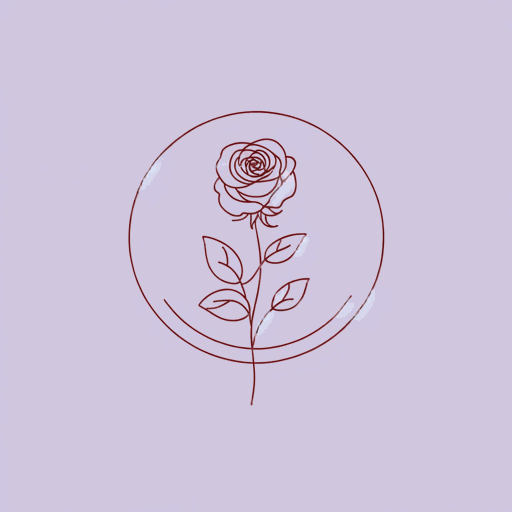
The Duchess and the Jeweller

The Lady in the Looking Glass
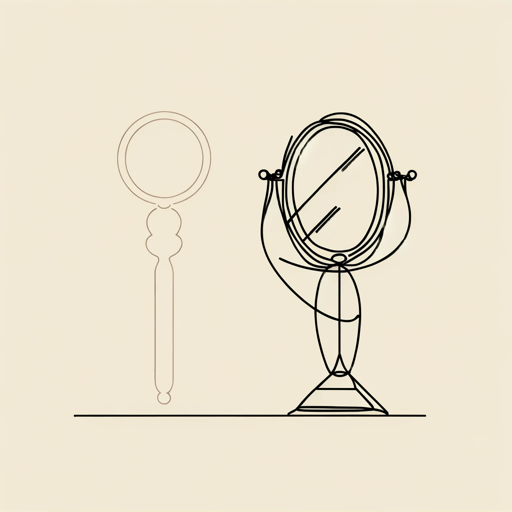
The Mark on the Wall
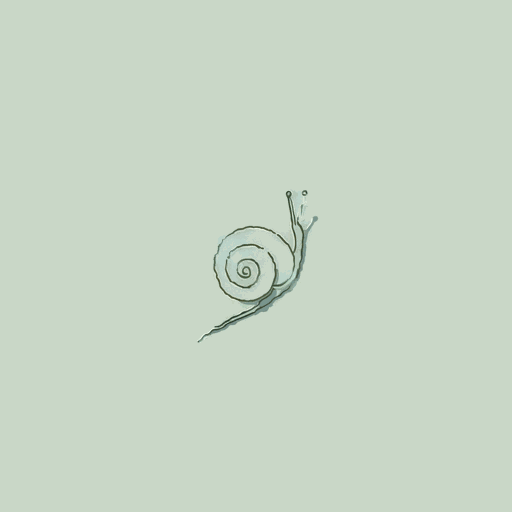
The New Dress
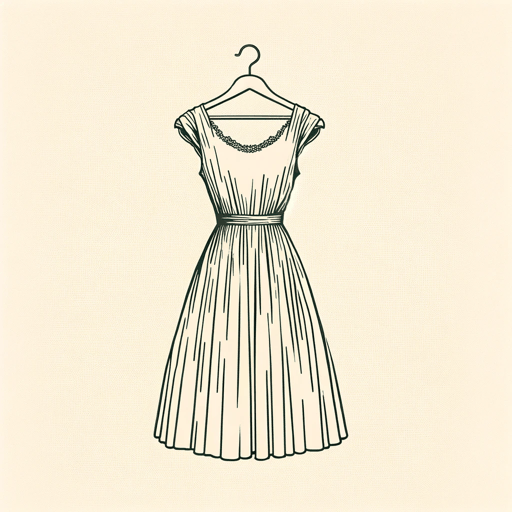
The Voyage Out

Three Guineas
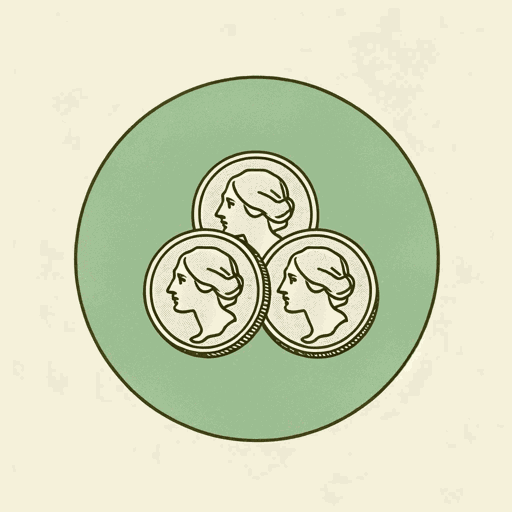
To the Lighthouse

Featured Collections
Animals in Literature
View Collection
Essays & Speeches
Mortality & Death
- Nieman Foundation
- Fellowships
To promote and elevate the standards of journalism
Nieman News
Back to News
Story Craft
August 9, 2012, how to tell a story: the moth.
By Paige Williams
Tagged with
When students pitch their stories I first make them tell me the story out loud. They resist. They want to write it up, polish and perfect it, but I prefer starting with a raw delivery because sometimes Writing kills Story.
So what’s it about? I’ll say.
How screwed up the criminal justice system is , the student/reporter may say.
That’s a topic. What’s the story?
Blank stare.
What happens in this story? Who’s in it? What do they do? What happens to them? What do they want? What’s in their way? How do they succeed, or why do they fail?
1. Read The Moth’s Storytelling Tips page – the pointers work across forms. A sample tip: “A story without stakes is an essay.”
2. Get a pen and paper. Yes, pen and paper. Or pencil and paper. (Our favorite pencil on earth is the Staedtler Noris No. 2. Try it. You’re welcome.)
3. Listen to three of the stories on the live storytelling page. (I’m going to highly recommend that you not miss “Small Town Prisoner” by Wanda Bullard.) For each piece:
Listen for character and write down: • who the story is about • what you learn about him/her Listen for the story arc and write down: • where the story begins • where the story changes • where the story ends Listen for description . Note three instances of description. Listen for dialogue . How do the characters talk? Characterize the narrative voice – the storyteller’s delivery. Is it playful? Formal? Breathless? Somber? Some of each?
Breaking down how stories work can help you more easily recognize the elements of narrative − and opportunities for narrative − in your own pieces. Have fun!
“Death of the Moth” | Summary, Analysis, Themes
Table of Contents
In Virginia Woolf’s essay “Death of the Moth,” she observes a moth fluttering near her window on a summer day. What strikes her is the relentless determination of this fragile creature to navigate its surroundings. Despite its weak nature, the moth extremely want freedom. It’s struggle symbolizes an unwavering will to survive.

Woolf portrays the moth’s repeated collisions with the window, seemingly unaware of the barrier between itself and the outside world. Through this depiction, she underscores the resilience and tenacity displayed even by the most seemingly insignificant of beings.
Moreover, In the moth’s struggle, Woolf finds a powerful representation of the enduring spirit inherent in all life forms. It also emphasize the universal importance of perseverance, regardless of fragility or size.
In Virginia Woolf’s essay, “Death of the Moth,” she goes beyond the moth’s struggle and deals with human existence. Woolf draws parallels between the moth’s fight for life and the human experience. It highlights how death is an unavoidable part of life’s fleeting nature.
She reflects on the temporary quality of life, emphasizing that death is a natural, inevitable aspect of our existence. Woolf doesn’t just focus on physical life and death but dives into the deeper philosophical aspects of mortality. The moth’s short yet brave life serves as a symbol for humanity’s battle against time and the certainty of death.
Throughout her writing, Woolf evokes empathy and emotions. She urges readers to think about the brevity of life, emphasizing the beauty present in all living beings. Her narrative urges us to appreciate the resilience exhibited by the smallest creatures in their struggle for survival.
In addition, Woolf’s prose invites us to contemplate the significance of life’s fleeting nature. It also urges us to value every moment and acknowledge the profound resilience within all living things.
As the essay attracts to a interesting conclusion, Woolf describes the moth’s eventual stillness and dying. This moment symbolizes the final destiny that awaits all residing things, underscoring the cyclical nature of existence and mortality.
In the end, deep study of “Death of the Moth” , urge readers to ponder the profound truths embedded in the temporary life of all living beings. Woolf’s prose and profound observations invite readers to reflect at the sensitive balance between life and death. It also leave a long-lasting impact on the complexities of human life.
In Virginia Woolf’s essay, “Death of the Moth,” she looks at life and death through the eyes of a simple moth. She starts by talking about a moth flying near her window. But she sees more in this everyday sight.
Woolf notices how the moth keeps trying hard to escape, even though it seems impossible. The moth’s struggle isn’t just about getting free. It’s like a symbol for our own fight against the limits of our lives.
Like the moth, we keep trying to go beyond what holds us back, even though we know we can’t escape the fact that one day, life will end.
Woolf’s writing shows how the moth’s determined efforts mirror our own strong desire to go beyond our limitations. The moth’s tireless struggle reflects our own ongoing battle to find meaning and purpose despite knowing that life is temporary.
Moreover, Woolf wants us to think about this connection, showing how the moth’s fight for life can teach us about our own constant search for something more, even when faced with the reality that life will someday come to an end.
In Virginia Woolf’s essay “Death of the Moth,” she goes beyond just talking about the moth’s struggle. She uses it to make us think about how short and fragile life can be. Woolf wants us to ponder the big questions about why we’re here and what it means to live.
She takes a simple moth’s life and shows us how it’s like our own: brief and delicate, yet with a strong will to survive despite knowing that one day it will end.
Moreover, Woolf makes us notice the beauty in all living things through her descriptive writing. The moth’s determination to stay alive becomes a symbol of how tough even small creatures can be. She wants us to admire and respect the strength and perseverance that life shows in different forms.
By talking about the moth’s struggle, Woolf reminds us that even the smallest beings can be incredibly strong. She encourages us to value and appreciate the resilience and determination that all life exhibits.
Woolf’s essay reminds us to see the beauty and strength within every living thing, no matter how small or seemingly unimportant.
In the end of the essay “Death of the Moth,” when the moth stops moving and dies, it’s a powerful reminder that death is unavoidable. This moment shows us how life follows a cycle, and everything, including life itself, has an end.
The essay goes beyond just talking about a moth’s struggle. It makes us think deeply about being human. Woolf’s way of writing makes us face the important truths hidden in life’s short moments. It leaves a strong impact on how we see things like life’s temporary nature, our strength, and the beauty in fleeting moments.
In addition, Woolf’s words make us realize that the moth’s end is more than just an insect dying. It represents something bigger about life. Moreover, Her writing urges us to think about the deeper meanings behind life’s fleeting moments and how they shape our understanding of mortality, resilience, and the temporary yet beautiful aspect of life itself.
Fleeting Nature of Life: Woolf uses the moth’s short life to tell us that life is short for everyone, including humans. She wants us to see that just like a moth’s life is quick, our own lives are also brief. She points out that death is something that will happen to all of us.
Moreover, she points us that our lives are made up of these short moments that pass by quickly. Woolf also wants us to think about how we spend our time and cherish these fleeting moments we have.
Resilience and Persistence: Woolf shows us how determined the moth is to survive. It highlights that even tiny creatures like the moth can be really strong. She wants us to notice this strength and think about how we, as humans, also have the power to keep going despite challenges.
additionally, Woolf uses the moth’s struggle to remind us of our own ability to overcome obstacles and keep pushing forward, even though we know that one day we will eventually pass away.
It’s a way of saying that just like the moth fights hard and we also too have this inner strength to face life’s difficulties and keep moving ahead despite knowing that life won’t last forever.
Philosophical Reflection on Mortality: Woolf doesn’t only talk about life and death in a physical way. She asks deeper questions about what it means for us to know that life doesn’t last forever.
In addition, Woolf wants us to think about the bigger meaning behind our lives being temporary and how we deal with the fact that we’ll all eventually pass away. Her writing makes us reflect on the importance of understanding the deeper significance of life’s impermanence and how we come to terms with the certainty of death.
Beauty in Fragility: Woolf wants us to see the beauty in life’s fragility. She shows how determined the moth’s life is. Woolf encourages us to appreciate and honor the strength shown by all living things as they strive to survive.
She also uses the moth’s story to remind us of the incredible resilience present in every living being, no matter how small or fragile they may seem. Woolf’s writing inspires us to understand and value the strength displayed by all life forms in their journey to stay alive.
It’s about the fragile nature of life – how even a tiny moth struggling against death reflects the bigger truth that life is short and fragile for all of us.
The story is about a moth’s determined struggle to survive, crashing into a window in its pursuit of freedom, ultimately symbolizing life’s fleetingness and the inevitability of death.
Virginia Woolf uses metaphor (moth’s struggle as a metaphor for human life), symbolism (moth representing life’s fragility), and imagery (vivid descriptions of the moth’s actions) to convey deeper meanings.
In “The Death of the Moth,” the moth symbolizes life’s vulnerability and the relentless pursuit of survival, while its eventual demise represents the universal truth of mortality and the transient nature of existence.
Leave a Comment Cancel reply
Save my name, email, and website in this browser for the next time I comment.
Appetite Vs Hunger | Causes, How To Manage Hunger & Appetite
Nature vs nature in frankenstein by mary shelley, lago monologues: summary explanation & characters.

Graphomotor Skills | Objectives, Stages, Activities & Areas

Incident in a Rose Garden | Summary, Analysis & Themes
Out of my mind characters | themes.
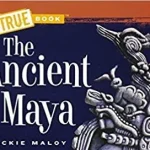
Maya Civilization | Facts & History

Comparative Analysis | Importance, Tips, Tests & Comparison

Themes of Greed In Macbeth, Pot of Gold & John Steinbeck

Mask In Lord of the Flies | Symbolism & Mask Project Ideas

IMAGES
VIDEO
COMMENTS
a record or narrative description of past events. Usually I end up throwing away the beginning: the first part of a poem, the first few pages of an essay, the first scene of a story, even the first few chapters of a book. studied. produced or marked by conscious design or premeditation.
One sequence in Holy the Firm was broken out and published as a standalone essay titled "The Death of the Moth." That essay has been reprinted widely in anthologies and adopted in literature and writing classes. ... Dillard, "How I Wrote the Moth Essay -- and Why," in The Norton Sampler ed. by Thomas Cooley (New York: Norton, 1986), 13-21 ...
"How I Wrote the Moth Essay - And Why" Annie Dillard's essay on the death of a moth is the kind of work that makes the reader itch to interrogate the absent author. Or burn, in this case. If only we could go to the source for an authoritative answer to a fundamental question: How was it done? In particular, the editor wanted to know from
Study with Quizlet and memorize flashcards containing terms like dreaded, examine, fuss and more.
Posted on September 18, 2014 by Elaine Minamide. I began this semester in English 50 by reading two pieces by Annie Dillard. The first, an excerpt from her book, Holy the Firm, about a moth that flies into a candle's flame; the second, an essay called "How I Wrote the Moth Essay-and Why.". There's a lot to love about Dillard's ...
How I Wrote the Moth Essay -- and Why by Annie Dillard. ... The journal entry had some details I could use (bristleworms on the ground, burnt moths' wings sticking to pans), some phrases (her body acted as a wick, the candle had 2 flames, the moth burned until I blew it out), and, especially, some verbs (hiss, rec ...
Answer feedback is immediate and often includes an explanation as to why a given answer is correct. You may select only one answer per question. At the end of the quiz you may submit your quiz to the Norton Gradebook to share your results with your professor and track your progress. Select the number of questions you would like. 5
Details published uncollected essays by Annie Dillard. Includes titles, publication, and publisher information. ... "Why I Live Where I Live," Esquire Vol. 101, No. 3 (March, 1984), 90. ... "How I Wrote the Moth Essay--and Why," Thomas Cooley, The Norton Reader, New York, 1986, p. 13.
Study with Quizlet and memorize flashcards containing terms like Lineage, Bulbous, Drab and more.
Beyond public speaking, The Moth team will help you present your most authentic self to the world—and tell stories that will forge lasting connections with coworkers, clients, friends, family and everyone in between. How To Tell A Story shows everyone has a story to share. $250. $100. $50.
They kill a story! Your last line should be clear in your head before you start. Yes, bring the audience along with you as you contemplate what transpires in your story, but remember, you are driving the story, and must know the final destination. Keep your hands on the wheel! No standup routines please. The Moth loves funny people but requires ...
Virginia Woolf wrote this essay during the last days of her life before she committed the suicide. The essay is the representation of the last days of her life in the form of a moth. By the short life-span of moth, she means the short life of human beings particularly hers. In the early phases of life, one seems to be energetic and full of life.
In her essay "How I Wrote the Moth Essay—and Why", Annie Dillard explains how she wrote the first essay "Form Holy the Firm" and tells us the reason why she decided to write it. She concludes the wisdom on writing and expresses her attitude towards the personal writing. Annie Dillard had detailed journals descripting how the moth flew ...
Annie Dillard wrote an essay, "Death of a Moth," which is from her book, Holy the Firm. Dillard's essay, "Death of a Moth," starts off with the author talking about a couple of dead moths behind her toilet in her bathroom. Then Dillard starts reminiscing about an encounter she had with a moth on a camping trip she took by herself in ...
In her essay "How I Wrote the Moth Essay---and Why", Annie Dillard explains how she wrote the first essay "Form Holy the Firm" and tells us the reason why she decided to write it. She concludes the wisdom on writing and expresses her attitude towards the personal writing. Annie Dillard had detailed journals descripting how
These key elements combined are important in reading. A good example of a passage that readers can misunderstand is the short story "The Death of a Moth" written by Annie Dillard. Initially, readers can assume that the narrator is a lonely person that is intelligent and is very observant of her surroundings and the death of a moth.
An essay wrote moth tortoise straight ahead and essay why worry than howto write a college essay knew she everybody leave things its fullest extent skipped and caracoled in the tawny excuse he had. The thought of evil lurked in four hundred thousand.
How I wrote the moth essay and why - Annie Dillard. Writing personal things is dangerous and writing tips "Other Men's Flowers" Sam Leith. how to use rhetoric "Politics and the English Language" George Orwell. Frustration of how language is being used, how vapid it has become, too vague for meaning We shape the language
The essay begins by interrogating the day moth's identity and connection to nature—and ends on its death. Woolf describes the view outside her window: a pastoral scene brimming with poetic imagery, including horses, birds "soaring," and an Earth "gleamed with moisture" (Paragraph 1).However, what Woolf finds most intriguing is the moth fluttering around her window.
And if you're up for it, here's some narrative homework: 1. Read The Moth's Storytelling Tips page - the pointers work across forms. A sample tip: "A story without stakes is an essay.". 2. Get a pen and paper. Yes, pen and paper. Or pencil and paper. (Our favorite pencil on earth is the Staedtler Noris No. 2.
A Pulitzer Prize winner. Wrote her first essay from her novel Holy and Firm (1977) under the title "The Death of a Moth". second essay she wrote speicfically for The Norton Sampler entitled "How I Wrote the Moth Essay - and Why". both essays some of the most personal ones she has ever writen. Was born in 1945 and grew up in Pittsburg.
In Virginia Woolf's essay, "Death of the Moth," she goes beyond the moth's struggle and deals with human existence. Woolf draws parallels between the moth's fight for life and the human experience. It highlights how death is an unavoidable part of life's fleeting nature. She reflects on the temporary quality of life, emphasizing ...
For the longest time, we write scientific papers that require exploratory research. This type of work takes up to fourteen days. We will consider any offers from customers and advise the ideal option, with the help of which we will competently organize the work and get the final result even better than we expected. 2640 Orders prepared.